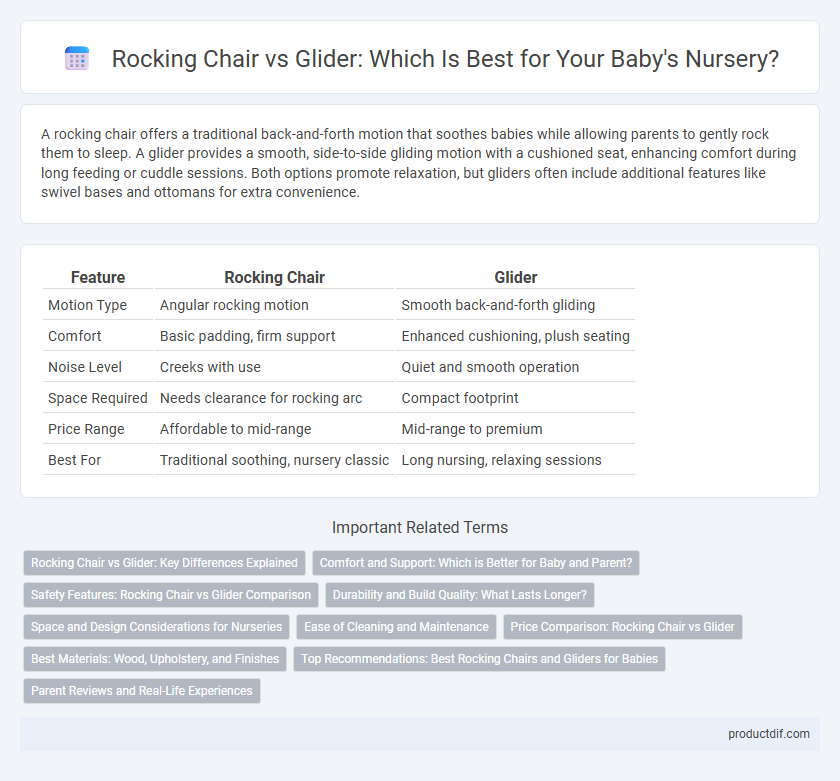A rocking chair offers a traditional back-and-forth motion that soothes babies while allowing parents to gently rock them to sleep. A glider provides a smooth, side-to-side gliding motion with a cushioned seat, enhancing comfort during long feeding or cuddle sessions. Both options promote relaxation, but gliders often include additional features like swivel bases and ottomans for extra convenience.
Table of Comparison
| Feature | Rocking Chair | Glider |
|---|---|---|
| Motion Type | Angular rocking motion | Smooth back-and-forth gliding |
| Comfort | Basic padding, firm support | Enhanced cushioning, plush seating |
| Noise Level | Creeks with use | Quiet and smooth operation |
| Space Required | Needs clearance for rocking arc | Compact footprint |
| Price Range | Affordable to mid-range | Mid-range to premium |
| Best For | Traditional soothing, nursery classic | Long nursing, relaxing sessions |
Rocking Chair vs Glider: Key Differences Explained
Rocking chairs feature a curved base that allows a gentle back-and-forth motion, ideal for soothing babies with a traditional rocking feel. Gliders move smoothly on a fixed track, providing a quieter and more controlled glide action that minimizes floor noise. Key differences include the rocking chair's characteristic rocking arc versus the glider's linear motion, impacting comfort, stability, and suitability for nursery use.
Comfort and Support: Which is Better for Baby and Parent?
Gliders offer smoother, more gentle motion and ergonomic support, promoting better comfort for both baby and parent during feeding or soothing sessions. Rocking chairs provide a traditional back-and-forth movement that some babies find calming, but they often lack the cushioned support and swivel features of gliders. Choosing between a glider and a rocking chair depends on the desired motion style and ergonomic comfort, with gliders typically favored for long-term use due to their enhanced cushioning and steady glide mechanism.
Safety Features: Rocking Chair vs Glider Comparison
Rocking chairs feature a smooth back-and-forth motion that can sometimes cause tipping hazards if not used on a flat surface, whereas gliders move in a gentle, linear motion on a fixed base, reducing the risk of accidental falls. Many gliders include locking mechanisms and padded armrests for enhanced infant safety and caregiver comfort. Choosing between the two depends on stability requirements and available space, with gliders generally offering superior safety features for active households.
Durability and Build Quality: What Lasts Longer?
Rocking chairs typically feature solid wood frames with traditional joinery, offering robust durability but may show wear over time due to repetitive rocking motion. Gliders often incorporate metal mechanisms and padded cushions, combining smooth motion with comfortable support, though moving parts can require maintenance to ensure longevity. For long-term use, selecting a rocking chair with high-quality hardwood or a glider with sturdy, well-engineered metal components provides the best balance between build quality and lasting durability.
Space and Design Considerations for Nurseries
Rocking chairs typically have a larger footprint and require more clearance for movement, making them less ideal for smaller nurseries. Gliders feature a smooth back-and-forth motion with a compact design, allowing better space management in tight nursery layouts. Many gliders also come with swivel options and modern upholstery choices, enhancing both functionality and aesthetic appeal in nursery design.
Ease of Cleaning and Maintenance
Gliders feature smooth, cushioned surfaces and removable covers, making them easier to clean and maintain compared to rocking chairs with exposed wooden or metal parts that can collect dust and require frequent polishing. Rocking chairs often have crevices where dirt and crumbs accumulate, demanding more detailed cleaning efforts. Choosing a glider reduces maintenance time while providing a cozy seating option, ideal for busy parents.
Price Comparison: Rocking Chair vs Glider
Rocking chairs for babies typically range from $100 to $300, offering a budget-friendly option with classic motion. Gliders, however, usually cost between $200 and $600 due to smoother, side-to-side movement and enhanced comfort features. Price differences reflect design complexity, material quality, and added amenities such as reclining positions or storage pockets.
Best Materials: Wood, Upholstery, and Finishes
Premium rocking chairs and gliders for babies often feature solid hardwood frames like oak or maple, providing durability and natural beauty. Upholstery materials such as breathable cotton, soft microfiber, or stain-resistant polyester enhance comfort and ease of cleaning. Finishes with non-toxic, VOC-free paints or natural oils ensure safety and maintain the furniture's aesthetic appeal while protecting the wood from wear.
Top Recommendations: Best Rocking Chairs and Gliders for Babies
Top recommendations for baby comfort include the Storkcraft Hoop Glider, known for its smooth, silent motion and ergonomic design, and the Dutailier Sleigh Glider, praised for its plush cushioning and durable hardwood construction. The DaVinci Kalani Rocking Chair offers a classic rocking experience with toxin-free finish, while the Baby Relax Mikayla Upholstered Glider provides a gentle glide combined with a 360-degree swivel for enhanced versatility. These options prioritize safety, comfort, and style, making them ideal for nursery seating and bonding time.
Parent Reviews and Real-Life Experiences
Parents often highlight that rocking chairs provide a soothing back-and-forth motion, making them ideal for calming fussy babies during bedtime routines. Gliders, praised for their smooth horizontal glide, offer a quieter, more fluid experience that reduces joint strain during extended use. Real-life reviews emphasize gliders' added comfort and ease of movement, while rocking chairs remain favored for their classic design and nostalgic appeal.
Rocking Chair vs Glider Infographic

 productdif.com
productdif.com